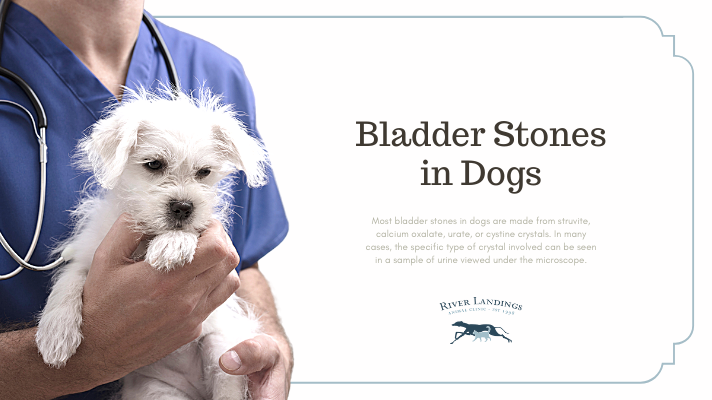Some of the most dramatic X-rays shown to clients are those that reveal the presence of large stones in their dog’s bladder. Until they see the X-rays, many of these folks are a little annoyed at their dog. This isn’t unreasonable, considering the dog often has accidents in the house or needs to go outside on an hourly basis. However, after seeing the X-rays, most owners are shocked that their dog hasn’t been acting even sicker.
What are the Signs of Bladder Stones in Dogs?
Bladder stones start out small but over time can grow in number and/or size. Dogs with bladder stones typically have some or all of the following symptoms:
Urinary accidents
Frequent attempts to urinate without producing much urine
Straining to urinate
Discolored urine
Licking around the urinary opening
These clinical signs can be seen with other diseases affecting the urinary tract (infections or tumors, for example), so the diagnosis of bladder stones has to be confirmed with either an X-ray or ultrasound.
How are Bladder Stones Formed and Treated?
Bladder stones are a collection of minerals and other materials. Most bladder stones in dogs are made from struvite, calcium oxalate, urate, or cystine crystals. In many cases, the specific type of crystal involved can be seen in a sample of urine viewed under the microscope.
If struvite is the diagnosis, a veterinarian will treat the underlying cause (e.g., antibiotics for urinary tract infections) and may recommend a therapeutic diet that will dissolve the stones and crystals. Dogs prescribed antibiotics will typically use the drugs while consuming the therapeutic dog food, and possibly longer if needed. Surgery or other procedures like lithotripsy (breaking up the stones with ultrasonic shock waves) will be necessary to get the stones out of the bladder. The therapeutic diet for dissolving struvite stones, however, must be given under a veterinarian’s supervision. This is because they are formulated to make the dog produce more acidic urine than they would otherwise in order to break down the stone. If urinary acidification is taken too far, calcium oxalate stones can be the result.
What’s the Best Way to Prevent Bladder Stones in Dogs?
Once the stones are gone, diet plays an important role in preventing their return. Manufacturers have formulated special foods that deter the formation of struvite, calcium oxalate, urate, and cystine crystals. Encouraging water intake is also important since crystals are less likely to form in diluted urine. For this reason, many veterinarians recommend the canned versions of these foods over the dry.
Because diets designed to prevent bladder stones have to be fed over the long term, they must be nutritionally balanced. Your pet’s doctor is in the best position to recommend a nutritionally complete, well-balanced food that will help keep your pet healthy.
Hear From Us Again
Don't forget to subscribe to our email newsletter for more recipes, articles, and clinic updates delivered straight to your e-mail inbox.
Related Articles:
The Life Threatening Emergency of Urinary Obstruction (and Bladder Stones) in Pets
Related Categories:







